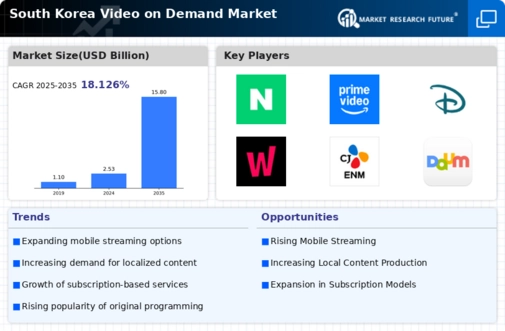Mobile Consumption Trends
The surge in mobile device usage is a critical driver for the video on-demand market in South Korea. As of November 2025, over 80% of video content is consumed via smartphones and tablets, reflecting a shift in viewing habits. This trend is largely attributed to the convenience and portability of mobile devices, allowing users to watch their favorite shows and movies anytime, anywhere. Consequently, video on-demand platforms are optimizing their services for mobile users, enhancing user interfaces and ensuring compatibility across various devices. The focus on mobile consumption not only broadens the audience reach but also encourages platforms to develop exclusive mobile content, thereby fostering engagement and loyalty among subscribers. This adaptation to mobile trends is essential for sustaining growth in the competitive landscape of the video on-demand market.
Diverse Consumer Preferences
The video on-demand market in South Korea is significantly influenced by the diverse preferences of its consumers. With a population that values both local and international content, platforms are compelled to curate extensive libraries that cater to varying tastes. As of November 2025, surveys indicate that 65% of viewers prefer localized content, while 35% lean towards foreign films and series. This dual demand encourages platforms to invest in original productions and acquire international licenses, thereby enriching their offerings. Additionally, the rise of niche genres, such as K-dramas and independent films, further diversifies the market landscape. Consequently, the ability to adapt to these preferences is crucial for platforms aiming to capture and retain subscribers in the competitive video on-demand market.
Competitive Pricing Strategies
Pricing strategies play a vital role in shaping the video on-demand market in South Korea. As of November 2025, the market is characterized by a variety of subscription models, including ad-supported tiers and premium offerings. This competitive pricing landscape allows consumers to choose plans that best fit their viewing habits and budgets. Approximately 45% of users prefer subscription services with lower monthly fees, while 30% are willing to pay for ad-free experiences. The presence of multiple players in the market fosters price competition, compelling platforms to innovate and provide value-added services. This dynamic pricing environment not only attracts new subscribers but also encourages existing users to explore different platforms, thereby driving overall market growth. The ability to implement effective pricing strategies is crucial for success in the evolving video on-demand market.
Cultural Influence of K-Content
The global popularity of Korean content, particularly K-dramas and K-pop, serves as a significant driver for the video on-demand market in South Korea. As of November 2025, the international demand for K-content has surged, with streaming platforms reporting a 50% increase in viewership for Korean titles. This cultural phenomenon not only attracts domestic viewers but also garners substantial interest from international audiences, leading to increased subscriptions. Platforms are increasingly investing in original K-content productions to capitalize on this trend, thereby enhancing their competitive edge. The cultural influence of K-content encourages platforms to expand their libraries and promote local talent, further enriching the video on-demand market. This focus on cultural exports positions South Korea as a key player in the global entertainment landscape.
Increasing Internet Penetration
The proliferation of high-speed internet access in South Korea is a pivotal driver for the video on-demand market. As of November 2025, approximately 98% of households have internet connectivity, with a significant portion utilizing fiber-optic networks. This widespread access facilitates seamless streaming experiences, allowing consumers to engage with content without interruptions. The video on-demand market benefits from this trend, as more users are likely to subscribe to various platforms, enhancing overall market growth. Furthermore, the increasing availability of mobile data plans enables users to access video content on-the-go, further expanding the audience base. The combination of affordable internet services and high-quality streaming options positions the video on-demand market for sustained growth in South Korea.




















Leave a Comment